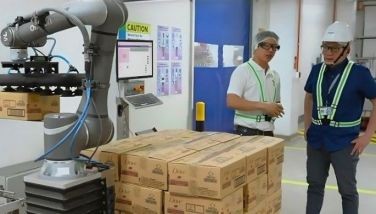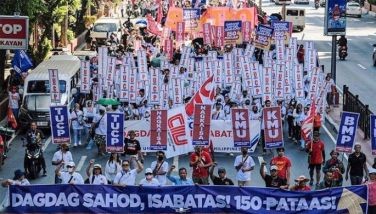Island hopper
September 23, 2002 | 12:00am
A backpacking foreigner walked into the ticketing office of South East Asian Airlines at the Manila Domestic Airport’s passenger terminal. The staff greeted him by name. Having had time to spare, he went to a nearby café for breakfast. That was where the flight attendant found him when his flight was announced.
"Frequent flyers consider us their personal airline," said SEAIR co-founder and director Nikos Gitsis. "They know the pilots, they know the staff, they know us. They call us directly when they have problems."
On its eighth year, SEAIR flies to more Philippine cities than any other local airline. At last count, it has regular flights to 22 destinations, five from Puerto Princesa to northern Palawan and nearby islands alone. By the end of the year, the number of destinations will increase by three to cover flights to Legazpi City in Albay, Cauayan in Isabela, and Calapan in Mindoro Oriental.
"Our destinations are not trunk line routes such as Manila-Cebu and vice-versa, which are admittedly the more profitable routes," said Gitsis.
Given its corporate direction to service destinations no longer covered or never covered by other local airlines, SEAIR has, however, chosen to keep its ticket prices down. "What we’re after right now is volume. The margins can wait," said co-founder and chairman Iren Dornier.
To date, SEAIR has invested more than P100 million in a single fleet of six LET-410s made in the Czech Republic, with two more to be delivered before the year ends. The 19-seater plane, which was designed for extreme environmental conditions such as Siberia, is ideal for short take-offs and landings.
"Because we’re focused on destinations where large planes will not go, the LET is a good choice. What we have is the new generation, the 5-blade UVP-E, which makes our fleet the youngest in the industry," said Dornier, a licensed transport pilot and flight trainer.
The purchase of the planes came with a Czech consultant, Lasty Talasek, who coordinates and orders parts from Europe. All the spare parts are originals. Once the imported parts, ranging from nuts and bolts to the larger plane pieces, are delivered, they are double checked by chief inspector Jaime Rider.
"You can imagine the cost involved. We pay everything–from nuts and bolts, which are the most frequently ordered, to the big pieces, which are ordered on an as-need basis– in dollars," said Rider.
SEAIR has a maintenance team of 45 licensed aircraft mechanics, spread out in the company’s hubs in Clark, Manila, Cebu and Zamboanga. To date, the company has a 100% safety record, which could be partly traced to a comprehensive training program given yearly by the aircraft and engine component manufacturers.
"Our maintenance program (for both our planes and those of others) is based on the MSG2," said Dornier. "It allows us to schedule and repair or conduct preventive maintenance in a step-by-step program so the aircraft does not have to be pulled out of service entirely. This partially in-house developed program helps us to save on some costs. Aside from the line maintenance, most of the work is done after sunset or before sunrise."
To maximize its maintenance team, the company has sought and gotten permission from the Air Transportation Office and the Civil Aviation Office to operate as a third party repair station.
The company also accepts maintenance work such as radio installation, life vest certification and painting work from other airline companies. Business has picked up enough to justify the leasing of a second hangar in Clark, which is dedicated to outside jobs.
For 2002, maintenance work is expected to contribute 2% to SEAIR’s total revenues.
The balance 98% will come from the commuter and chartered business, a more balanced revenue mix than SEAIR’s 100% chartered business to the resorts in Palawan and Boracay in its early years.
Over the next three years, SEAIR will need $45 million in fresh money to make significant inroads in the local airline industry. "We have had talks with investors from China and the United States," said Dornier.
The big plan is to buy bigger LET planes that can seat 50 to 70 passengers but can still land and take off from the small runways that are the norm in the country.
Potential investors will probably find SEAIR a more viable investment once it gets its ISO-9001-2000 certification and the nod from the International Association of Travel Agents. Both are expected before the year ends.
"We’ve been doubling growth for the past two years. We expect to grow by 50% this year and by 25% next year," said Gitsis. A major factor in these projections is SEAIR’s designation as one of the carriers of the BIMP EAGA (Brunei, Indonesia, Malaysia, Philippines East Asian Growth Area).
"Our team is not just composed of businessmen who are in it for the money. We happen to be a corporate family of aviation specialists and enthusiasts who know the industry and every aircraft in and out," said Dornier.
In the last eight years, SEAIR’s stakeholders have also shown their commitment to the Philippines.
"Frequent flyers consider us their personal airline," said SEAIR co-founder and director Nikos Gitsis. "They know the pilots, they know the staff, they know us. They call us directly when they have problems."
On its eighth year, SEAIR flies to more Philippine cities than any other local airline. At last count, it has regular flights to 22 destinations, five from Puerto Princesa to northern Palawan and nearby islands alone. By the end of the year, the number of destinations will increase by three to cover flights to Legazpi City in Albay, Cauayan in Isabela, and Calapan in Mindoro Oriental.
"Our destinations are not trunk line routes such as Manila-Cebu and vice-versa, which are admittedly the more profitable routes," said Gitsis.
Given its corporate direction to service destinations no longer covered or never covered by other local airlines, SEAIR has, however, chosen to keep its ticket prices down. "What we’re after right now is volume. The margins can wait," said co-founder and chairman Iren Dornier.
"Because we’re focused on destinations where large planes will not go, the LET is a good choice. What we have is the new generation, the 5-blade UVP-E, which makes our fleet the youngest in the industry," said Dornier, a licensed transport pilot and flight trainer.
The purchase of the planes came with a Czech consultant, Lasty Talasek, who coordinates and orders parts from Europe. All the spare parts are originals. Once the imported parts, ranging from nuts and bolts to the larger plane pieces, are delivered, they are double checked by chief inspector Jaime Rider.
"You can imagine the cost involved. We pay everything–from nuts and bolts, which are the most frequently ordered, to the big pieces, which are ordered on an as-need basis– in dollars," said Rider.
SEAIR has a maintenance team of 45 licensed aircraft mechanics, spread out in the company’s hubs in Clark, Manila, Cebu and Zamboanga. To date, the company has a 100% safety record, which could be partly traced to a comprehensive training program given yearly by the aircraft and engine component manufacturers.
"Our maintenance program (for both our planes and those of others) is based on the MSG2," said Dornier. "It allows us to schedule and repair or conduct preventive maintenance in a step-by-step program so the aircraft does not have to be pulled out of service entirely. This partially in-house developed program helps us to save on some costs. Aside from the line maintenance, most of the work is done after sunset or before sunrise."
The company also accepts maintenance work such as radio installation, life vest certification and painting work from other airline companies. Business has picked up enough to justify the leasing of a second hangar in Clark, which is dedicated to outside jobs.
For 2002, maintenance work is expected to contribute 2% to SEAIR’s total revenues.
The balance 98% will come from the commuter and chartered business, a more balanced revenue mix than SEAIR’s 100% chartered business to the resorts in Palawan and Boracay in its early years.
The big plan is to buy bigger LET planes that can seat 50 to 70 passengers but can still land and take off from the small runways that are the norm in the country.
Potential investors will probably find SEAIR a more viable investment once it gets its ISO-9001-2000 certification and the nod from the International Association of Travel Agents. Both are expected before the year ends.
"We’ve been doubling growth for the past two years. We expect to grow by 50% this year and by 25% next year," said Gitsis. A major factor in these projections is SEAIR’s designation as one of the carriers of the BIMP EAGA (Brunei, Indonesia, Malaysia, Philippines East Asian Growth Area).
"Our team is not just composed of businessmen who are in it for the money. We happen to be a corporate family of aviation specialists and enthusiasts who know the industry and every aircraft in and out," said Dornier.
In the last eight years, SEAIR’s stakeholders have also shown their commitment to the Philippines.
BrandSpace Articles
<
>
- Latest
Latest
Latest
January 10, 2025 - 9:30am
January 10, 2025 - 9:30am
January 7, 2025 - 9:00am
January 7, 2025 - 9:00am
January 6, 2025 - 10:45am
January 6, 2025 - 10:45am
January 2, 2025 - 2:00pm
January 2, 2025 - 2:00pm
December 17, 2024 - 12:00am
December 17, 2024 - 12:00am
December 16, 2024 - 10:00am
December 16, 2024 - 10:00am
Recommended






























